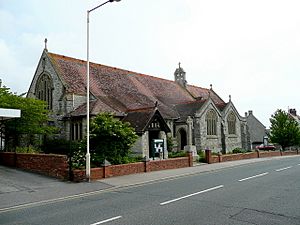St Paul's Church, Weymouth facts for kids
Quick facts for kids St Paul's Church |
|
|---|---|
 |
|
| Religion | |
| Affiliation | Church of England |
| Ecclesiastical or organizational status | Active |
| Year consecrated | 1900 |
| Location | |
| Location | Westham, Weymouth, Dorset, England |
| Architecture | |
| Architect(s) | George Fellowes Prynne |
| Architectural type | Church |
St Paul's Church is a special church in Westham, Weymouth, England. It belongs to the Church of England. A famous architect named George Fellowes Prynne designed it. Most of the church was built between 1894 and 1896.
Since 1974, it has been a Grade II listed building. This means it is an important historical building. The World War I memorial outside the church is also listed as Grade II. People who study buildings have called its design "unique but impressive."
Contents
The Story of St Paul's Church
Why St Paul's Church Was Built
St Paul's Church was built for the people living in Westham. Westham grew into a new part of Weymouth in the late 1800s. At first, a smaller church building, called a chapel of ease, was set up in 1880. This helped people attend church closer to home.
By 1892, more than 2,000 people lived in Westham. The small chapel was no longer big enough for everyone. So, a meeting was held in June 1892 to plan a new, larger church. A group was formed to collect money for the project. They bought land for the church for £655. In 1893, architects shared their ideas for the church. George Fellowes Prynne's design was chosen.
Building the Church
Enough money was raised to start building in 1894. Mr. W. H. Gooding from Exeter was hired as the builder. The first stone, called the foundation stone, was laid on May 9, 1894. A special ceremony took place with important people attending. These included the Bishop of Salisbury and the Mayor of Weymouth.
At first, there was only enough money to build part of the church. This first part would hold 400 people. There were some problems with the builder, and work stopped for a short time. Then, the architect, George Fellowes Prynne, took over the project himself.
The first part of the church was finished in 1896. The Bishop of Salisbury officially dedicated it on January 25, 1896. This section included parts of the main area (nave), an aisle, a transept, the altar area (chancel), and rooms for the clergy and organ. A temporary section was also built at the west end. By this time, £5,600 had been spent. However, £1,850 of that still needed to be raised.
Becoming a Parish Church
Over the next few years, the committee kept raising money. By 1900, the debt was much smaller, only £600. In May 1900, a meeting was held to discuss officially making St Paul's a full parish church. A parish is an area that has its own church and priest.
The Bishop of Salisbury agreed to consecrate the church on October 18, 1900. This would happen if the debt was reduced to £300 by October 1. Also, an architect had to confirm the church was strong enough to be a parish church. The community successfully raised £450.
So, the Bishop consecrated the church on October 18, 1900. In 1902, Westham officially became its own parish, with St Paul's as its main church. A small side chapel was added in 1903. All the permanent building work on the church was completed in 1913.

